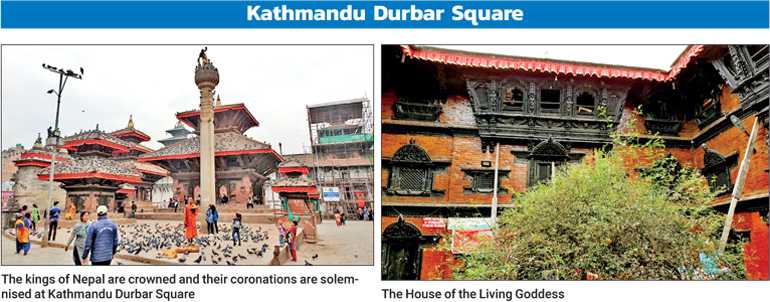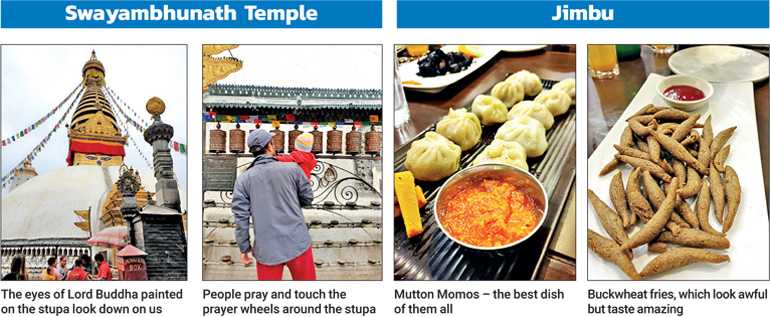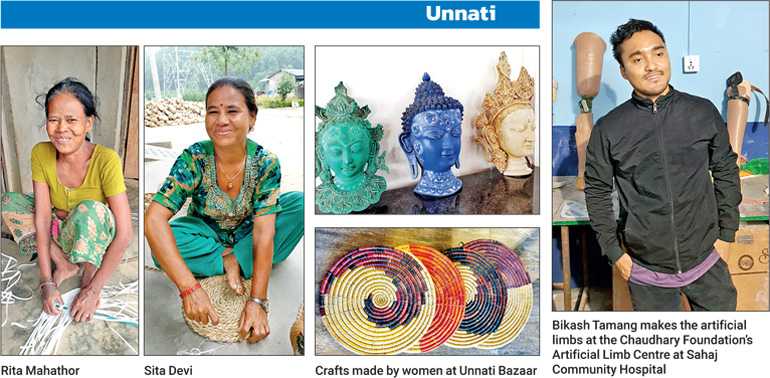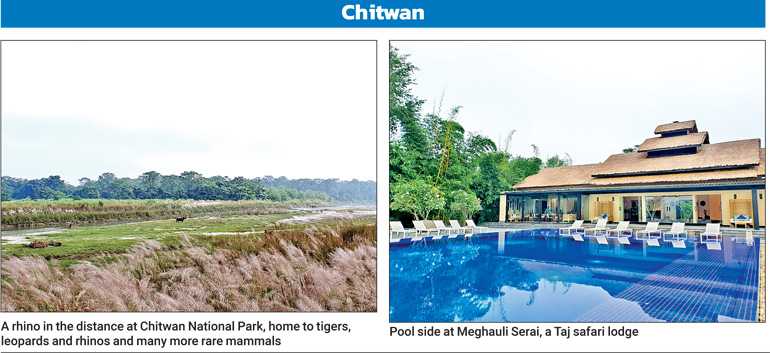Sunday Dec 07, 2025
Sunday Dec 07, 2025
Wednesday, 13 November 2019 00:00 - - {{hitsCtrl.values.hits}}
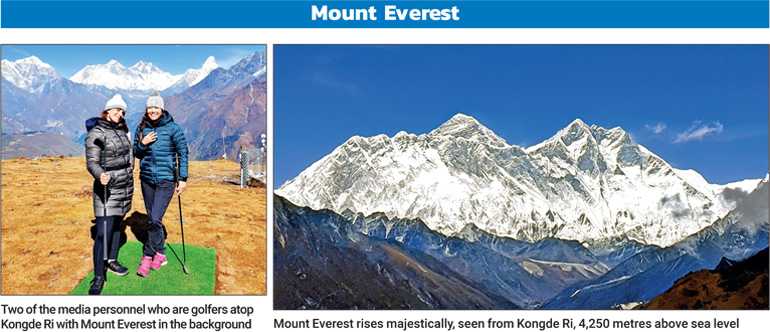
By Marianne David
What better way to spend a clear day in Nepal than gazing upon Mount Everest as she shows her face? It’s 9 a.m. in Kathmandu, the sun’s out, the clouds have disappeared, and we’re wrapped up, ready and raring to go!
It’s our fourth day in Nepal and finally the weather has cleared enough for choppers to fly to Lukla (the world’s most dangerous airport!) and from there to Kongde Ri, a mountain in the Himalaya of eastern Nepal.
After a long wait for the all-clear, the helicopter carrying our all-female team of five media personnel – and flown by a female pilot to our delight – finally takes off from Kathmandu at 11. The 45-minute flight to Lukla is amazing and terrifying – the sights are to die for, but you’re constantly aware of your own mortality! We’re flying high on excitement and anticipation, thrilled to be among those chosen to fly to Kongde Ri.
In Lukla, there’s another long wait as we acclimatise. Hunger sets in after some two hours and we order ramen – the only thing on the menu in the small place adjoining the Lukla chopper landing field – but before our meal is ready, the chopper’s here.
We take off and five minutes later, we land at Kongde Ri, 4,250 metres above sea level, and cannot believe our luck. Right in front of our faces Mount Everest rises majestically, shining in the sun, the snow caps burning brilliant as she shows herself.
It is exhilarating, it is humbling, it is the highest point on earth I will ever be in my lifetime and I feel like I’m on top of the world. The weather couldn’t be more perfect and it holds. We walk around, take endless pictures, and gaze in awe at the majesty that surrounds us. We cannot believe we are finally here. And we’re here for a long time, which is thrilling at first and slowly becomes worrying.
We’ve been told not to stay at Kongde Ri for more than 15 minutes due to altitude sickness and risk of the weather turning against us, but the next chopper comes to get us only after 55 minutes. We’re relieved to see it, to say the least.
It’s time to head back to Lukla where we have another long wait until another chopper arrives to take us back to Kathmandu. Just a few days ago a few members of the team had got stuck in Lukla and we aren’t ready to be stranded here.
Time for momos!
Back in Kathmandu, after a hot shower and some rest, it’s time to head out for some momos! Having asked around for a good place to go, we settle on Jimbu, which is a short walk away from the Taj Vivanta. Vivek, the owner, helps us choose; the recipes are his mother’s.
First up is the Mutton Sukuti Sandeko (dried meat with ginger and garlic), followed by Buckwheat fries, which look awful but taste amazing! We then tried Dhung (mutton blood sausage with herbs), which was a bit too charred to enjoy, followed by some amazing Vegetable Momos, drenched in a soupy gravy.
Next up were Mutton Momos – the best dish of them all and a huge hit here – and Mutton Thakali. We leave stuffed and fully satisfied.
Empowering women and the disabled
Wednesday dawns, our fifth day in Nepal, and it’s time to head out to Chitwan, a five-hour journey by road provided there’s no traffic.
Our first stop is at Unnati Bazaar at Shashwat Dham. Unnati is an initiative of the Chaudhary Foundation, focused on women’s empowerment through livelihood programs. We also visit the homes of two women whose lives have changed thanks to the initiative and watch them at work, awed by the fluid magic of their weaving.
Rita Mahathor is engaged in a recycling project, weaving floor mats and fans. Her weaving style is traditional, yet the material used is modern – the strips of plastic from beer packaging. She’s a widow engaged in agriculture, horticulture and animal husbandry and the project enables her to earn a little extra to care for herself and her aged mother-in-law.
Rita has high expectations of this project and wishes to continue long-term, she tells us with a wide smile, as she weaves away at high speed.
Sita Devi, who weaves mats using dried riverside grass, says the project has made her independent. Her products are neatly made and as she showcases them, she smiles with pride. “I would rather do this than do nothing – it keeps me engaged and gives me money for my own expenses,” she says.
We then visit the Chaudhary Foundation’s Artificial Limb Centre at Sahaj Community Hospital and talk to a young man who makes the artificial limbs, Bikash Tamang (25), himself a recipient of an artificial limb from a Chaudhary Foundation fitment camp. The story of how his life has turned around completely is one of hope and resilience and bears witness to the power of goodness and generosity in changing lives.
Safari time!
Another hour’s drive and we reach Meghauli Serai, a Taj safari lodge. The property is enchanting and luxurious and the hospitality is truly heart-warming.
Meghauli Serai heavily focuses on preserving Nepal’s culture and heritage and this is showcased at the cultural performance that night, featuring the food of the ‘Tharus of Terai’ tribe and traditional dances. When we return to our rooms, we are impressed to find a document about the history of the tribe, their lifestyle and food.
At 7 a.m. the next day it’s safari time at Chitwan National Park, and we’re hoping for sightings of tigers, leopards and rhinos. The safari lasts close to four hours but only one of our wildlife dreams comes true – we spot many rhinos! Sightings of tigers and leopards are rare, our guide tells us, but rhinos are common. There are 605 rhinos in this park, while Nepal has a total of 645 rhinos.
As we make our way through the dense vegetation, hoping for more exciting sightings, we chance upon a trail of undisturbed tiger prints, but it vanishes into thin air. Our safari ends with a sighting of a rare gharial crocodile sunning itself.
Durbar Squares
On day seven, we visit more historic places in Nepal – the Bhaktapur and Kathmandu Durbar Squares and Swayambhunath Temple, one of the most sacred religious sites in Kathmandu.
The Bhaktapur Durbar Square is easily the finest of the three Durbar Squares in Kathmandu Valley and was listed as a World Heritage Site in 1979. The square is a mix of stone and metal art, wood carvings, terracotta art and architecture. The palace of 55 windows, the bell of barking dogs, and the Taumadhi Square stand out in this beautiful place.
At Kathmandu Durbar Square, also a UNESCO World Heritage Site, there is a lot of restoration work going on. Several buildings in the Square had collapsed during the major earthquake in April 2015.
Most buildings are in the pagoda style, featuring intricately-carved exteriors. It is here that the kings of Nepal are crowned and their coronations solemnised. It is also where the Kumari Ghar, the house of the Living Goddess, is located.
Swayambhunath Temple, also known as Monkey Temple, finds us climbing up the wrong set of stairs first, which brings us across many monks (and monkeys!) after which we find our way to the stupa.
The eyes of Lord Buddha painted on the stupa look down on us and people pray and touch the prayer wheels that circle its base as they move around the stupa.
We end the evening in Thamel, filled to bursting point with shops, bars and eateries. We have to resist the urge to buy too much despite heady temptation. There’s trekking gear galore and gorgeous shawls and yak wool blankets are in abundance.
The day ends with dinner at the Garden of Dreams, a neoclassical historical garden built in 1920, featuring pavilions, ponds and pergolas. The food is on point and the drinks are exceptional.
On Saturday we head out to the Gokarna golf resort, for phase II of the golf tournament organised by Nepal’s Baahrakhari Media Ltd. We also visit Chaudhary House to thank Chaudhary Group Chairman Binod Chaudhary for his gracious hospitality and then head to Budanilkantha for dinner. It’s quite cold there but the warm company and great conversation more than make up for it.
The Living Goddess
Sunday dawns. It’s our last day in Nepal and it’s Deepavali. We visit the Kathmandu Durbar Square one last time. Today the Living Goddess comes to her window while we are there; she looks down on the gathered people through heavily kohl-rimmed eyes for a few seconds and she’s gone. Seeing her is believed to bring good fortune, but she looks sad and alone.
It’s no surprise, really – she seems to be only around five years old, lives a secluded life and is rarely seen in public. Selected after a stringent process including 32 body perfections and signs of fearlessness amid animal sacrifices, largely kept away from her family, her feet not allowed to touch the ground until the Goddess Taleju departs from her body, and her every action interpreted for meaning, being the world’s only Living Goddess is hard – and life after being dethroned is even harder.
As we head out, in and around the Durbar Square even the dogs are decked in garlands and people are wishing each other on this special day.
A multi-ethnic country, home to people of many origins, Nepal is filled with blessings and beauty despite political tribulations and high vulnerability to natural disasters.
Tourism drives the country, being its largest industry and largest source of revenue, and Nepal certainly does not disappoint travellers. It truly is a fantastic place to explore, offering exhilarating mountain adventures, amazing cultural experiences, culinary delights and so much more.

